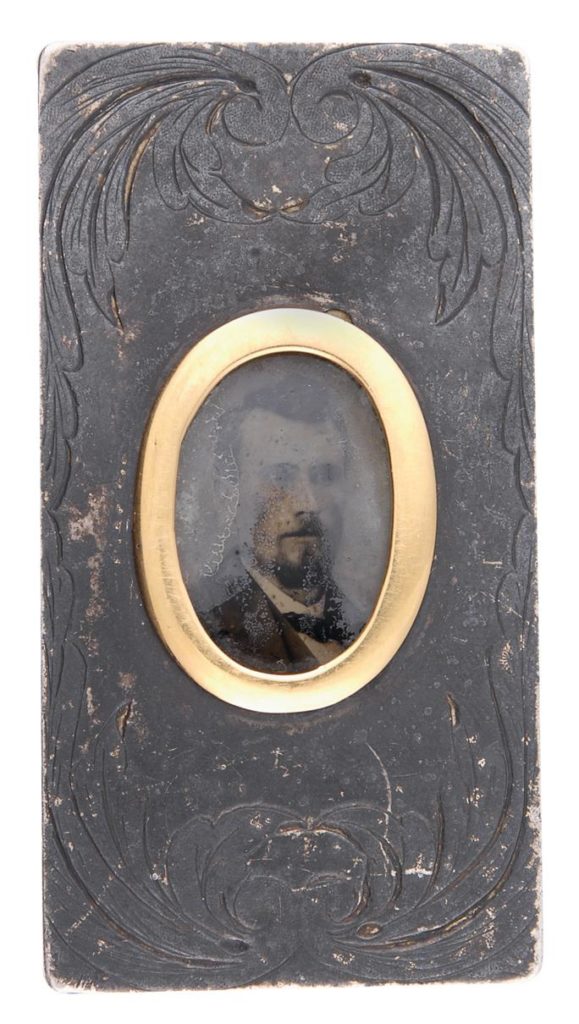Nevada. Treasure City, White Pine County. 1870-dated presentation ingot. Silver, unmarked.


Approximately 16 ¼ ounces. 68.7 mm x 36.1 mm x 21.1 mm. Oval photograph, housed in gold-rimmed brass frame, measures 21.8 x 28.1 mm and is inset into an oval divot in the top face of the bar roughly 4 mm deep. The top face shows a leafy peripheral decoration.
The broad bottom face is inscribed “J. G. Lee to John Lee” in fancy script, framed with an apparently hand-punched decoration around the periphery. The sides are engraved “Nevada” at top, “White Pine” at left, “1870” at base, and “Treasure City” at right. Deep gray toning covers most of the ingot, though the inscribed base has been lightly polished to brilliant silver gray. Some lighter gray coloration appears where the darker toning has worn through handling, such as the centers of the sides and the corners.
A well made ingot, carefully smoothed and prepared for presentation. No bad marks are seen and, clearly, this has been well-maintained since its creation. The inside of the oval space made for the photograph shows hand tooling marks and was somewhat crudely accomplished. A tiny fingernail gap just right of the top of the photograph allows for the intact photograph and frame to be removed and replaced, but the custom fit is tight enough that the photograph will not come out of the bar unless intended. The photograph, somewhat cloudy at top and sides, depicts a dark haired man, perhaps 35, with a neat goatee in a jacket and bow tie.
Treasure City is today a ghost town, located in White Pine County near Ely, Nevada, not far from the Utah border. Treasure City changed its name from Tesora in August 1869, at the height of the silver boom there. The town’s population was well depleted by the end of 1870, when the mines started to show diminishing marginal returns, and just a few years later was all but a ghost town. Despite the usual ghost town accoutrements of saloons, general stores, brothels, and tens of thousands of miners, Treasure City and nearby Hamilton ceased to exist nearly as quickly as they had come into being. No John Lees appear in the White Pine County census for 1870, which was taken during the first two weeks of June of that year. Needless to say, such censuses are always incomplete and often badly so. Deeper research could discover who these two Lees were and what their connection to the Treasure City region was.
Three notable assayers were active in Hamilton, Nevada in 1870: Edward Ruhling, Sidney Van Wyck, and H.W. Theall. All are best known for their work in Virginia City, clear across the state, but set up offices in White Pine County circa 1870 to capitalize on the boom there. Theall actually died in Hamilton in May 1869, and his business passed to Van Wyck’s control. Van Wyck apparently lived in White Pine County himself, as he is listed in the census for 1870 as living in Hamilton, Nevada with his wife and four children. It seems likely that this unmarked presentation ingot was made by either Ruhling or Van Wyck. Presentation ingots such as this could be given out for any imaginable reason, though the usual recipients seem to be those involved with ownership of or investment in the area’s mines. While the Ford collection contained a number of interesting presentation ingots, including some from Nevada, none were so personal as to include a photograph of the presenter or recipient. We have never heard of a photographically illustrated ingot aside from this and would not be surprised to known it was unique. It is certainly the most distinctive Western assay ingot we can recall seeing or handling.
[04/2009] https://www.worthpoint.com/worthopedia/silver-ingot-paperweight-dated-1870-119783289 ($1,400)
For a similar portrait presentation ingot also made in White Pine 1870, see: https://rareingot.com/joseph-t-kennedy/
